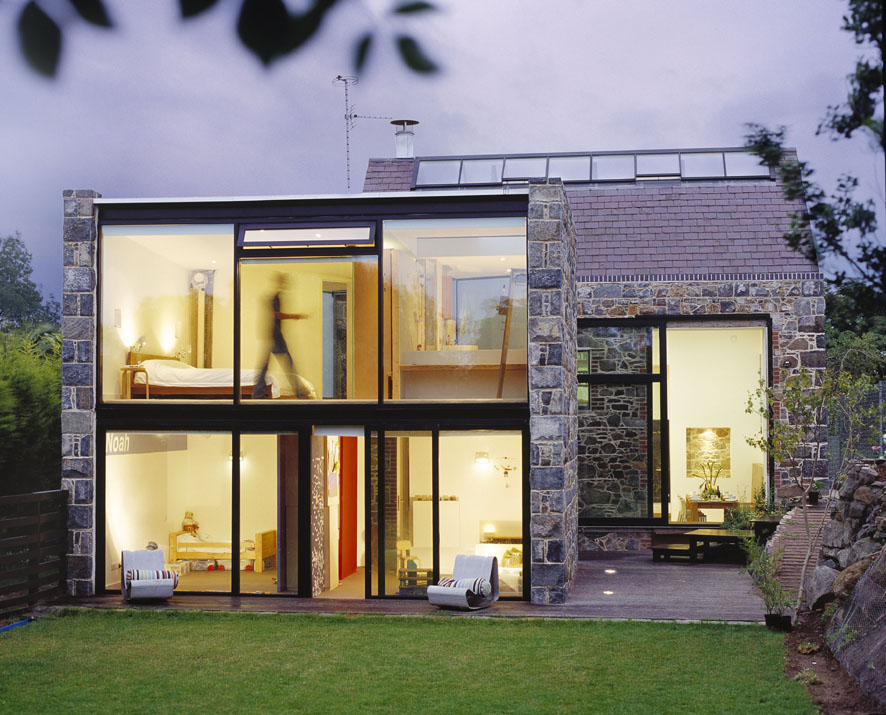Extension design above by Jamie architect from Guernsey. See more and shortlist them for your home project here.
For anyone undertaking a home building, renovation or extension project, one of the first questions to ask yourself is: am I in a conservation area? It may have significant implications for your project from a planning perspective. This subject is particularly pertinent in London and historic cities in the UK such as Bath, Durham, Oxford etc, where conservation areas are widespread.
Am I in a conservation area?
Firstly, you’ll need to do a conservation area search on your local planning authority’s website. All local planning authorities can be found with your postcode via the gov.uk website here: https://www.gov.uk/find-local-council (opens in a new tab on your browser)
Usually, your local council’s website will have a search bar on their website where you can simply type in ‘conservation areas‘, which should show you a map of your area. As an example, here is a map of the conservation areas in Hackney:
Planning permission in a conservation area
Being in a conservation area means that your planning proposal will need to be more sensitive to the local heritage and historical architectural language than normal. That said, it certainly doesn’t mean your new build house or extension should be a carbon copy of the Edwardian townhouse next door. A good architect can work with you to come up with a design that is sympathetic to the area yet contemporary. In fact, the local conservation officer may well prefer this.
If you are in a conservation area, your application will be scrutinised by said local conservation officer. They will be looking for high quality design that enhances and preserves aspects of the local area. It’s always worth calling your local planning department and getting as much information as you can before you and your architect start the design phase of the project. They may ask you to pay for pre-application advice. As your application will likely be under more design scrutiny than normal, it can be really worthwhile doing this and starting the design dialogue as early as possible.
You may find our other article useful: should I pay for planning pre-application advice?
Do we have any permitted development rights in a conservation area?
Permitted development rights do still exist in conservation areas, although they are reduced. However, in some cases, permitted development rights may be completely removed if there is an Article 4 direction associated with your conservation area.
What’s an Article 4 Direction?
An article 4 direction is made by the local planning authority to remove or restrict permitted development rights. It can be for a particular area (e.g. a whole conservation area), site or type of development.
An article 4 direction does not mean the proposal would be forbidden – it simply means that a planning application and consent will be required.
Do we need conservation area consent?
Conservation area consent is an additional application to the usual planning application and is required if you are planning demolition works:
- to a building with a volume of more than 115 cubic metres (there are some exceptions – check with your local planning department)
- to demolish a gate, fence, wall or railing over two metres high OR over one metre high if it’s next to a public open space or a highway (including a public footpath).
However, you should always check with your local planning office, even if your proposals don’t involve the above.
Finding the right architect
Planning and conservation officers respond well to high quality design that is well thought through and sympathetic to surroundings. It’s also important that the proposal is presented in the best light to demonstrate these qualities. This is why finding a great architect is so important to the success of your project.
Design for Me is a free platform to help you quickly find the right architect for your home project. My name is Emily Barnes and as a residential architect myself, I started Design for Me after finding that talented and innovative smaller firms and individuals, who are perfectly placed to design new homes, extensions and/or renovations, can often get buried under the online profiles of large commercial companies.
Before Design for Me, the right architect was very difficult to find!
Once you register your project, we’ll match it with 100s of top architects, and you will see who’s available and eager to work on your project straight away.
Emily Design for Me

